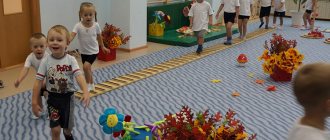MAGAZINE Preschooler.RF
“Finger gymnastics as a means of speech development for preschool children”Bolotova Natalya Viktorovna Teacher-speech therapist of the highest qualification category MBDOU "Kindergarten of compensatory type No. 17" Sergiev Posad municipal district Moscow region, Sergiev Posad,
annotation
This article examines the relevance and usefulness of finger games as a means of speech development during correctional and educational work in preschool institutions. The purpose, tasks of finger gymnastics, and the rules for its implementation are described. Examples of finger games for classes with children, “tied” to the study of lexical topics for the 1st period of study (September-November) are given.
Topic: “Finger gymnastics as a means of speech development for preschool children”
The popularity of finger games has increased significantly. Such games are not a newfangled hobby for modern parents. They have existed among different peoples since ancient times. And no wonder, because finger games are a wonderful way to cheer up a child, distract him from something, and find contact with any child.
The development of the motor side of speech depends not only on the functional capabilities of the facial-articulatory muscles directly involved in the implementation of speech acts; The development of a child’s speech is also indirectly related to the state of his general motor skills, i.e. motor activity in general.
Previously, it was believed that the main thing on which speech development depends is the degree of verbal communication between children and surrounding adults. However, research by scientists has shown that the degree of verbal communication with adults does not play as big a role as expected. They also studied the relationship between a child's speech ability and his motor functions. Studying the anatomical relationships of the child’s body, scientists, neuropathologists and defectologists came to the conclusion that the child’s speech ability depends not only on the training of the articular apparatus, but also on the movements of the fingers. The hand can be classified as a speech apparatus, and the motor projection area of the hand can be classified as
Consultation for educators “The importance of finger games in the development of speech in preschool children”
To teach a baby to speak, it is necessary not only to train his articulatory apparatus, but also to develop fine motor skills of the hands, which leads to an improvement in the relationship between the hemispheres of the brain and the synchronization of their work. The fact is that in the human brain the centers responsible for speech and finger movements are located very close. By stimulating fine motor skills, we also activate the connection areas responsible for speech.
In the right hemisphere of the brain we have various images of objects and phenomena. And in the left they are verbalized, that is, they find verbal expression. This process occurs thanks to the “bridge” between the right and left hemispheres. The stronger this “bridge”, the faster and more often nerve impulses travel along it, the more active the thought processes become, more precisely the attention, the higher the abilities. If you want your child to speak well, learn quickly and easily, and deftly perform even the most delicate work, start developing his hands: fingers and hands from an early age.
To determine the level of speech development, speech therapists have long developed the following method: the child is asked to show one finger, two fingers, three fingers. If the movements are tense, the fingers bend and straighten only together and cannot move separately from each other, then these are children with problems in speech development. This means that it is necessary to engage in finger games with children as much as possible.
When to start exercising.
There are periods in a child's development when he is most teachable. For speech development, this period is from one and a half to three years of age. It is then that the child masters the basic means of the language in which communication is carried out, the foundations of speech behavior are laid, and a special sense of language is formed. It is natural that only by the age of three years, the movements of a child’s fingers become similar to the movements of an adult’s fingers.
Work on training fingers can begin with children aged three months. Gymnastics with such kids is in the nature of easy tactile communication. With the help of simple stroking of the palms and fingers, pulling the fists closed around the parent’s finger, the child masters the world around him and himself, and receives psycho-emotional support.
At the age of 6-7 months, systematic training should be carried out: this includes massage of the hands and each finger, each of its phalanxes. Kneading and stroking are carried out daily for 2-3 minutes.
Already from the age of ten months, active exercises are carried out for the fingers, involving more fingers in the movement with good amplitude. Exercises are selected taking into account age characteristics. So, kids can be given wooden balls of various diameters to roll with their fingers. You need to involve all your fingers in the movement. For this exercise you can use plasticine balls and beads. You can design with cubes and assemble various pyramids.
How to do finger gymnastics?
Babies can perform finger exercises directly after about a year. From this time you can start classes. To make them interesting, usually each game is accompanied by a certain rhythmic text - poems, nursery rhymes, fairy tales, which are “dramatized” with the help of fingers and palms. An adult must pronounce the words of the game rhythmically and expressively. This helps the child learn to formulate his speech correctly and beautifully. Children's imagination is actively involved in the game, and they do the exercises with pleasure.
The basic rules for such activities are as follows.
- An adult’s hands should not be cold (after all, games involve both demonstration of movements, as well as their correction and mutual participation).
- Before starting gymnastics, you need to do a general warm-up for your hands and fingers so that they warm up and become more pliable (just as it is important for an athlete to stretch the necessary muscles before a performance or match).
- During games, it is important to ensure that the child uses all fingers in the exercises.
- When carrying out such gymnastics, parents should not only monitor how the child performs the exercises, but also exert a tactile influence on the baby’s hands (stroking, tickling).
- Games should not be held in a forced manner, otherwise they will do more harm than good.
- The key to success is systematic training.
Advice
For children who can already make choices and have preferences, you can create a card index of games. Teach your child to look at the pictures on the cards so he can choose which exercises he wants to do that day. Follow his choice for several days. Try to somehow change those exercises that he systematically rejects: choose a more lively text, add emotions, change the picture on the card, dilute the game, for example, with rhythmic musical accompaniment.
If a child under 3 years of age has lost interest in finger gymnastics in an “ideal” form, you can switch him to another type of exercise - playing with objects:
- rolling round objects (plastic balls, balls, small fruits) across the table or floor;
- sorting cereals or small construction parts;
- pyramid assembly;
- building a tower from cubes;
- putting together a mosaic;
- painting with fingers (on flour, sand, cereals, scattered in a thin layer);
- examination by touch of materials with different textures (silk, fur, polyethylene, wood, metal, feathers, plastic, terry or woolen items, etc.).
From about 2 years old, you can transfer finger games with children to paper. You can roll it into balls or roll it into thin paper strips. Fingers work great if you ask the child to tear small pieces from a whole sheet. Let the child put the resulting scraps into a small glass.
Why do you think finger games have become popular these days? Yes, because parents, who are terribly busy with their work, began to talk to their children less and less. And the children themselves talk less and listen and watch more. And they rarely do anything with their own hands.
It is known that there is a close connection between speech function and the human motor system. The higher the child’s motor activity, the better his speech is developed. The same close connection is between the hand and the speech center of the brain. Harmony of body movements, fine motor skills of the hands and speech organs contributes to the formation of correct pronunciation, normalizes its pace, teaches compliance with speech pauses, and reduces mental stress.
Finger games and exercises are a unique tool for speech development. Learning texts using “finger” gymnastics stimulates the development of thinking, attention, and imagination. The child remembers poetic texts better, his speech becomes precise and expressive.
Finger games based on folklore material are most effective for the development of a small child. They are informative, fascinating, and literate in their didactic content.
The artistic world of songs and nursery rhymes is built according to the laws of beauty. The essence of folklore texts is action. Actions of characters, movement of events.
Before you start finger gymnastics, make sure that the children know the main characters of the poems and songs. First, show the children toys or color pictures so that the children can remember what certain animals look like that will be talked about in a nursery rhyme, song, or poem. Then offer to depict it with your fingers. If necessary, you need to show how this or that animal can look like using your fingers.
Gradually, finger gymnastics can be complicated: you read the first line of the poem - the baby depicts an action, then read the next line - the child depicts another action, etc. This way you can act out the entire nursery rhyme or song.
Such games and exercises should be carried out regularly with young children. Children develop better when they are successful and feel that they are doing well and adults are happy with them. Praise kids even for the smallest successes.
Recommendations for conducting finger games with a child.
- Before playing a game, you need to discuss its content with your child, immediately practicing the necessary gestures, finger combinations, and movements. This will not only prepare the baby to perform the exercise correctly, but will also create the necessary emotional mood.
- The exercise should be performed together with the child, while demonstrating your own passion for the game.
- When playing the game repeatedly, children often begin to pronounce the text partially (especially the beginning and ending of phrases). Gradually, the text is learned by heart, children pronounce it in its entirety, correlating the words with the movement.
- Having chosen two or three exercises, gradually replace them with new ones. You can keep the games you like most in your repertoire and return to them at your child’s request.
- Do not give your child several complex tasks at once (for example, showing movements and pronouncing text). Children have a limited attention span, and an impossible task can “discourage” interest in the game.
- Never force. Try to understand the reasons for the refusal, if possible, eliminate them (for example, by changing the task) or change the game.
- Encourage children to sing along, “don’t notice” if they do something wrong at first, encourage success.
What happens when a child does finger gymnastics?
1. Performing exercises and rhythmic movements of the fingers inductively leads to excitation in the speech centers of the brain and a sharp increase in the coordinated activity of speech zones, which ultimately stimulates speech development
2. Finger games create a favorable emotional background, develop the ability to imitate an adult, teach them to listen attentively and understand the meaning of speech, and increase the child’s speech activity.
3. Children learn to concentrate their attention and distribute it correctly,
4. If the child performs the exercises correctly, accompanying them with short poetic lines, then his speech will become clearer, rhythmic, bright, and control over the movements performed will increase.
5. The child’s memory develops, as he learns to remember certain hand positions and sequences of movements.
6. Children develop imagination and fantasy. Having mastered all the exercises, he will be able to “tell” whole stories with his hands,
7. As a result of mastering all the exercises, the hands and fingers acquire strength, good mobility and flexibility, and this will make it easier to master the skill of writing in the future.
Finger games are an easy and enjoyable way of development for the youngest children. After all, children learn the world through touch.
Passive gymnastics (massage)
It is better if an experienced professional shows you the massage technique, but you can master the simplest techniques yourself.
The massage is performed with one hand, the other holds the massaged hand. Session duration: 3 – 5 minutes; carried out several times a day.
Massage includes the following types of movements:
- Stroking - performed in different directions;
- Rubbing - differs from stroking with a greater force of pressure (the hand does not slide over the skin, but moves it);
- Vibration - applying frequent blows with the tips of half-bent fingers;
- Massage using a special ball - with the ball you need to make movements in a spiral from the center of the palm to the tips of the fingers; practical advice: you need to use a hard ball, that is, it should not be easily deformed (then the impact will be maximum);
- Flexion-extension of the fingers - the fingers are initially clenched into a fist, each in turn is extended and massaged from the side of the palm in a circular motion from the base to the tip.
We talk more about massage here.





